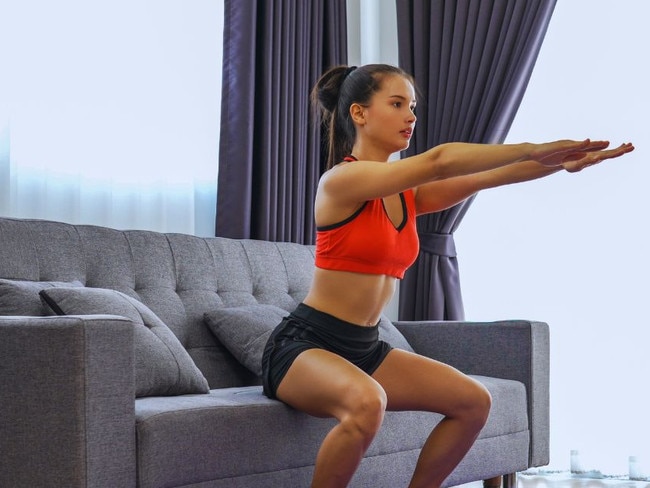Fit in just five minutes? Try this easy workout
Scientists have developed a routine that fits into your day – and boosts muscle strength and mood. But you have to prioritise this type of movement.
Strength Training
Don't miss out on the headlines from Strength Training. Followed categories will be added to My News.
If you’re worried that you’re too sedentary or too short on time to exercise, scientists have good news for you. Researchers have discovered that a workout of just five minutes a day can give a significant boost to your physical and mental health.
Exercise scientists at Edith Cowan University (ECU) in Australia have shown that eccentric training, where you work against gravity to perform the lowering phase of a movement in a slow and controlled way, has many benefits including boosted muscle strength and better mood.
They have now devised a simple routine of the exercises that requires only a few minutes of your time and can be done as you go about your day – they can be performed at separate times and no gym gear is required.
Professor Ken Nosaka of ECU’s School of Medical and Health Sciences has been studying the benefits of eccentric exercise for more than a decade and calls it an overlooked “key for better health”.
Most of us, he says, focus on the lifting of weights or the pushing up in exercises such as squats, when in fact it is the reverse movement that brings greater gains.
“When muscles work eccentrically, as they do when lowering a dumbbell, descending stairs and sitting in a chair slowly, they are gradually stretched under tension,” Nosaka says.
“When you focus on the eccentric phase of a movement, muscles are able to perform a greater number of repetitions with the same load.”

When it comes to strength, eccentric exercise provides better results with less effort.
“It has been shown in many studies that eccentric muscle contractions produce greater strength in muscles than concentric contractions,” Nosaka says. “Basically, you are working your muscles harder but with less effort than in other forms of exercise.”
The best part is that you only need to spend a few minutes exercising this way to get results. For his latest trial in the European Journal of Applied Physiology, Nosaka and his colleagues recruited 22 healthy but sedentary people who were prepared to complete a daily exercise routine consisting of 10 repetitions of chair squats, chair reclines, wall push-ups and heel drops, all prioritising the eccentric lowering phase of each movement. The workout could be spread out over the day and in total took no longer than five minutes.
Results after four weeks were impressive, even in those who managed the exercises only five days a week. “We saw significant gains in muscle strength, flexibility and strength endurance,” Nosaka says.
He also measured markers of mental health, such as mood and stress levels, and found that they too improved.

Previous studies have shown that the brain works harder during eccentric exercise than other forms of activity, which suggests that it brings anti-ageing cognitive benefits. George Morris, an exercise physiologist and strength coach at St Mary’s University, Twickenham, says that this is just one of the reasons it is important to balance any resistance training with elements of eccentric muscle work as we get older.
“We also know that eccentric muscle contractions are a major player in the prevention of age-related muscle loss from midlife onwards,” Morris says.
“Studies have shown that eccentric strength is better maintained in older muscles and, because it requires less energy than other forms of strength work, it is easy to stick to it even in your seventies and eighties.”
You can also work at your eccentric training even if you’re already a keen gym enthusiast or runner. For one of his previous studies in the Scandinavian Journal of Medicine and Science in Sports, Nosaka looked at the effects of a three-second dumbbell curl performed in different ways. “One group performed an ‘eccentric’ lift, which meant lowering the weight down from the shoulder so that the elbow joint was forcibly extended and the muscle lengthened,” he says.

“A second ‘concentric’ group slowly lifted the weight upwards meaning the muscles shortened, as in a biceps curl, and the ‘isometric’ group held the weight in place at the midpoint.”
After four weeks all participants had stronger biceps but the eccentric lifters had the biggest gains, with arm muscles 11.5 per cent stronger than when they started, compared with a 6-7 per cent improvement among other participants.
And while uphill running gets plaudits for strengthening glutes and hamstrings, downhill running involves eccentric contraction of the quadriceps muscles at the front of the thigh. One study in Scientific Reports found that 14 days after a single 30-minute downhill running session, athletes reported feeling less fatigue from a flat-ground run, suggesting the downhill running had an effect on reducing muscle fatigue.
A five-minute routine is all you need to get started, though. “We think that limiting the exercise time to five minutes is important so that it becomes a daily routine,” Nosaka says.
“Even if you progress to more advanced versions of the bodyweight exercises or add more sets as you get stronger, you should keep the number of eccentric contractions to ten per set for maximum effect.”
Nosaka believes that we should all weave eccentric muscle strengthening into our lives in other ways too. “There are simple ways to get stronger,” Nosaka says.
“I try to lower myself really slowly whenever I sit down, and I try to walk down slopes and stairs as often as possible – every eccentric contraction you make is a step towards better health.”
The eccentric bodyweight workout
Start with 10 repetitions of each basic exercise a day, for a minimum of 5 days a week.
The exercises can be scattered throughout the course of your normal day. As you get stronger, progress to the advanced versions of an exercise but stick to 10 repetitions. Add more sets as you become more proficient.
Chair squats
How to do them: Stand with your back to a sturdy dining chair and place hands on your upper thighs for support. Lower your body to a seated position, taking 3-5 times longer than normal to sit down.
Progression: Stand on one leg and lower into the chair. Perform 10 repetitions on each leg.
Chair reclines
How to do them: Sit on the edge of a dining chair with feet firmly planted on the ground and your knees bent at 90 degrees. Cross hands in front of your chest and, keeping your back straight, tighten your abdominal muscles. Slowly recline backwards with your torso, moving shoulders towards the back of the chair. Allow your heels to lift slightly from the ground. Return to the start position and repeat.
Progression: Sit-ups.
Wall push-ups
How to do them: Stand facing a wall and place palms flat against the surface. Push your arms out from the shoulders until they are straight and your legs and torso remain in a straight line. Bend your arms at the elbows to lower your body slowly towards the wall, keeping your legs and torso in a straight line and your feet well planted on the ground. Allow your nose to touch the wall then push back to the starting position and repeat.
Progression: Knee push-ups and then full push-ups on the floor.
Heel drops
How to do them: Stand with your heels off the edge of a step or platform, holding on to a wall or banister for support. Slowly lower your heels below the level of the step to the end of your ankle range of movement. Push back to the start position and repeat.
Progression: Perform one-legged heel drops in the same way. As you get stronger do the same exercise holding a dumbbell in the right hand as the left heel lowers (and vice versa).


